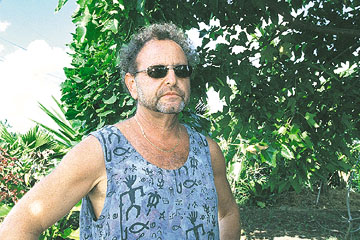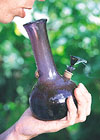"Part of the war on marijuana is the propaganda war. The opposition deals with anything they can throw at us. They're not constricted by the truth." Buck Donham, public information specialist for the Big Island police department
"Go to a beach pavilion, and the buds are on the table. Obviosly there's more than enough to go around, but people are beginning to question whether this ia healthy activity for ou children to see." Wes Margheim, adult services coordinator for the Big Island Substance Abuse Council |
 Lorn Douglas believes his daughter Elyse became addicted to "crack" cocaine when Hawaii's eradication program caused pot prices to soar.
Twenty-four years of eradication may have altered the marijuana industry on the Big Island, but it’s hardly going away. “The only thing I’ve seen eradication change is the price of marijuana, not the availability,” said Phil Geraci, a counselor at Hilo High School. “It’s been my experience that most people here don’t pay for it. It’s either traded or they grow their own or they rip it off from somebody.” A 15-year-old sophomore from Hilo High School listed the beaches and hangouts where he sees marijuana every day — Four Mile Beach, Lanes, Containers. But he said marijuana and other drugs have virtually disappeared from Hilo High because of a zero-tolerance policy that levies an automatic transfer to an alternative school for anyone caught with drugs or alcohol. That has left Hilo High an island of sobriety in a community where marijuana is rampant, Geraci said. “Here in Hilo, there is a serious marijuana problem,” he said. “It has hurt families. It pulls people apart. It makes anyone who abuses it less of a person, and that affects every part of them, not only their families but their productivity with society.”
Even when marijuana is the only drug present, it creates problems by killing motivation and ambition, Margheim said. The $400-an-ounce price on the Big Island also drains family incomes. “It affects men and women both,” Margheim said. “There are arguments, neglect of children, lack of responsibility.” Elyse Douglas was a 21-year-old Hilo Community College student and a marijuana smoker who was stoned most of the time. She still managed to own a modest house and was otherwise doing fine, said her father, Lorn Douglas, a custom chopstick maker from Kehena. Elyse Douglas remembers when an ounce of pot went from $275 to $300. “If you wanted really good quality, I paid $600 one time,” she said. There is considerable debate about whether the crackdown on marijuana created an opening for harder, cheaper and more dangerous drugs such as crystal methamphetamine, or “ice.” Elyse Douglas believes her addictive personality would have led her to crack eventually. Her father maintains the price of pakalolo drove her to it. “She just couldn’t afford pot anymore,” Lorn Douglas said. “So a friend said, ‘Try this.’ From that day, she went from a regular kid into a crack addict and an outlaw.” The difference in drugs was as dramatic as it was dangerous, Elyse Douglas said. “With marijuana, I was stoned all of the time, but with crack I was stealing, would hurt anyone, do anything to get my drugs,” she said. “My dad is my only parent, and I stole from him. I was hanging out with heavy, big-time drug dealers in very precarious, dangerous situations, stealing.” One night, Douglas tracked his daughter to the home of a drug dealer, forced her into the car and drove her to the Hilo police station, where officers said they had been looking for her. Elyse Douglas went through drug treatment on the Big Island, spent 18 months in a California half-way house and now works as a traffic court clerk in Santa Barbara, Calif. This year, at 28, she celebrates five years of sobriety. Looking back at what his daughter went through, Douglas said: “I’m very proud of my daughter, and yes, I’d prefer she had stayed on marijuana. It’s a crime that marijuana’s against the law.”
|
|||||||||||||||||||||||||||||||||||||||||||||||||
